Making The Most Of Chicken
By Mike on Sunday, April 29, 2012, 18:56 - Permalink
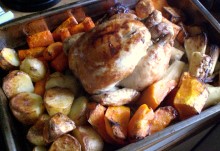 Lean times - and everyone is looking for ways to cut costs - so how about squeezing three hearty family meals out of one standard chicken?
Lean times - and everyone is looking for ways to cut costs - so how about squeezing three hearty family meals out of one standard chicken?
This isn't a recipe, so much as a mildly philosophical ramble on the subject of culinary efficiency and frugality.
The Star Of The Show

I'm using just one standard chicken, weighing in at a little under a kilo and a half.
Full price, this would have cost £4 - already fairly cheap - but if you've got a little freezer space, there are ways to bring the cost down - as in this case, there was a multibuy offer - 3 for £10, reducing the price to £3.33 per bird.
But I did even better than that - I went shopping just before closing time and found a stack of chickens reduced down to £2.65 each, so I snapped up ten of them and stored them in my chest freezer.
The Plan
I'm going to make a big Sunday roast, and I'm going to plan to create leftovers for two more meals as I go.
Planning to make leftovers sounds like it could be wasteful, but in fact, it's another way to save, because cooking (say) twice the normal amount of carrots uses considerably less than twice the amount of fuel (there's also another small saving in that the pan only needs washing once).
Meal One
Sunday lunch will be: Roast chicken with roast vegetables (potatoes, parsnips, carrots, sweet potato and butternut squash), additional boiled/steamed vegetables - more carrots, swede(rutabaga), sweetcorn, peas and broccoli, and gravy, lots of gravy.
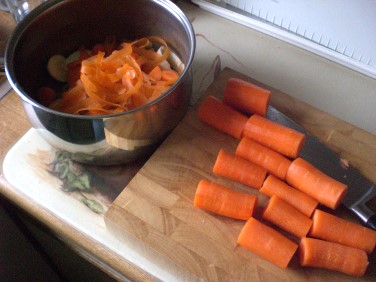 So the first thrifty tip: when preparing the vegetables, the trimmings from many of them go into a big saucepan, which will later be used to make stock from the chicken bones.
So the first thrifty tip: when preparing the vegetables, the trimmings from many of them go into a big saucepan, which will later be used to make stock from the chicken bones.
So in here went the skins and tops/tails of carrots, parsnips, onions, swede, plus some bits of tough broccoli stalk. Not in here: peelings from potatoes, sweet potatoes and squash, as these tend to soak up flavour in a stockpot, rather than contribute to it.
 The carrots, potatoes, parsnips and sweet potatoes all need parboiling before they go in the roasting pan, but rather than boiling them separately and draining, I cook them one after another in the same water, lifting them out with a slotted spoon when they're starting to soften on the outside.
The carrots, potatoes, parsnips and sweet potatoes all need parboiling before they go in the roasting pan, but rather than boiling them separately and draining, I cook them one after another in the same water, lifting them out with a slotted spoon when they're starting to soften on the outside.
There are two reasons for this: by using the same hot water over again, I save energy compared to heating it from cold, but also, I'm not going to throw away the cooking broth - by the time it's had four lots of vegetables parboiled in it, it's loaded with flavour, so I set it aside for use in making the gravy, later.
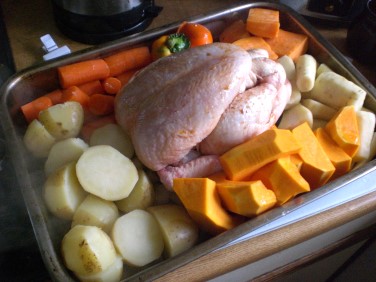 The chicken sits on a bed of chopped onions in the middle of the roasting pan, surrounded by the vegetables and the whole lot is seasoned and drizzled with a little oil, then placed in the oven to cook. As an afterthought, I threw in a bell pepper (whole, seeds and all) that was lurking in the fridge.
The chicken sits on a bed of chopped onions in the middle of the roasting pan, surrounded by the vegetables and the whole lot is seasoned and drizzled with a little oil, then placed in the oven to cook. As an afterthought, I threw in a bell pepper (whole, seeds and all) that was lurking in the fridge.
(This isn't directions for a recipe, but it took about an hour and a half at 170C - a bigger bird will take longer).
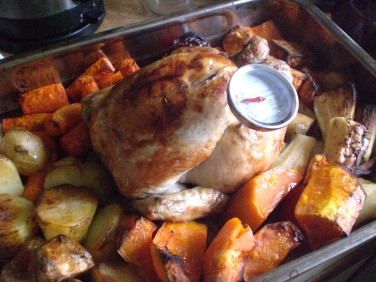 Halfway through cooking, I turned the chicken over so it could cook evenly (and so the breast meat would stay moist), then I turned it back for the last ten minutes so the skin on top could brown up.
Halfway through cooking, I turned the chicken over so it could cook evenly (and so the breast meat would stay moist), then I turned it back for the last ten minutes so the skin on top could brown up.
A meat thermometer pushed into the thickest sections of the breast and thigh confirmed that it was done (and the juices running clear).
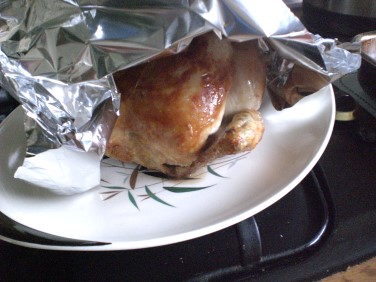 There was still half an hour to go until lunch, so I removed the chicken to a large plate and covered it with foil to rest - it stays surprisingly hot for at least half an hour, and allowing the meat to rest like this ensures that it will be moist and juicy.
There was still half an hour to go until lunch, so I removed the chicken to a large plate and covered it with foil to rest - it stays surprisingly hot for at least half an hour, and allowing the meat to rest like this ensures that it will be moist and juicy.
Meanwhile, I transferred the roast veg to an ovenproof serving dish and returned them to the oven and I lit the gas under the pan with vegetables to be boiled/steamed (a triple steamer - carrots/swede in the bottom, then broccoli, then peas and sweetcorn - saving energy by cooking all on one heat source)
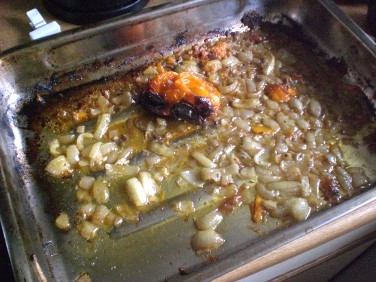 I also spread out the onions in the roasting pan and put this back in the oven to brown a little.
I also spread out the onions in the roasting pan and put this back in the oven to brown a little.
The roasted bell pepper here could have been served as a side vegetable, but I decided just to add it all to the stockpot for flavour.
 I set aside the cooked onions and spooned most of the fat out of the roasting pan - this is a combination of fats from the chicken and the oil I originally added to the vegetables at the start - it's too good to waste, so this will be saved for use in meal two or three.
I set aside the cooked onions and spooned most of the fat out of the roasting pan - this is a combination of fats from the chicken and the oil I originally added to the vegetables at the start - it's too good to waste, so this will be saved for use in meal two or three.
I poured half of the vegetable broth (from parboiling) into the pan to loosen all of the caramelised brown bits.
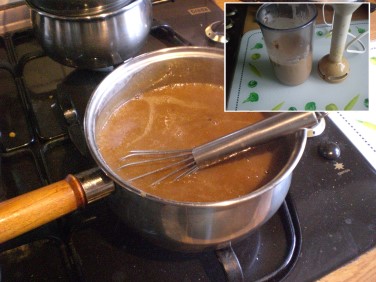 I mixed the other half of the parboiling broth with the onions and blended them to a smooth pulp with a hand blender, then brought this back together with the other half (complete with the dissolved browned bits from the roasting pan) and added some seasoning and a little sprinkle of gravy thickening to make about a litre and a half of gravy - more than I expected to need at the table.
I mixed the other half of the parboiling broth with the onions and blended them to a smooth pulp with a hand blender, then brought this back together with the other half (complete with the dissolved browned bits from the roasting pan) and added some seasoning and a little sprinkle of gravy thickening to make about a litre and a half of gravy - more than I expected to need at the table.
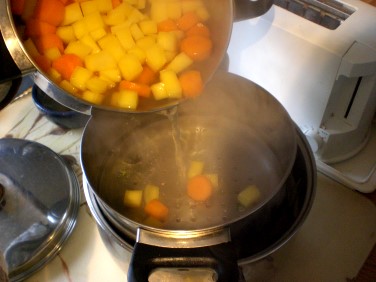 The boiled/steamed vegetables were done - again, there's flavour in the cooking liquor, so again, it's not going to waste - I drained the vegetables into the stockpot.
The boiled/steamed vegetables were done - again, there's flavour in the cooking liquor, so again, it's not going to waste - I drained the vegetables into the stockpot.
There'll be even more crafty ways to add flavour to this pot shortly (read on...)
 At the dinner table, I served all of the vegetables in dishes, but with the chicken, I carved and served a generous portion for each diner, then took the remainder out of the way to the kitchen and covered it up.
At the dinner table, I served all of the vegetables in dishes, but with the chicken, I carved and served a generous portion for each diner, then took the remainder out of the way to the kitchen and covered it up.
This removes the temptation to pick at the chicken until it's all gone (and you feel you've eaten too much). If anyone wants seconds, there's plenty of additional vegetables and gravy.
Obviously, this really only works for something like a family meal where everyone is on board with the notion of being frugal - guests might just consider it mean and miserly.
After Lunch
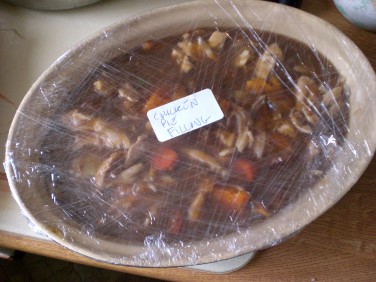 In one of the serving dishes (saving on washing up) I placed a selection of the leftover vegetables, cut into rough chunks. To this, I added about two thirds of the leftover chicken meat, picked from the bones.
In one of the serving dishes (saving on washing up) I placed a selection of the leftover vegetables, cut into rough chunks. To this, I added about two thirds of the leftover chicken meat, picked from the bones.
The remaining gravy was just enough to cover all this. I wrapped the whole dish several times in cling film and labelled it - the objective here was to make three meals - not necessarily three consecutive ones - so this dish will go into the freezer and at some later date (so no photo of the end result just yet), I'll just thaw it out, top with pastry to make a delicious family-sized chicken and veg pie - meal two.
 I picked the last of the chicken meat from the bones and set this aside (for meal 3). The bones, skin and other parts of the chicken carcass went in the stockpot.
I picked the last of the chicken meat from the bones and set this aside (for meal 3). The bones, skin and other parts of the chicken carcass went in the stockpot.
It needed topping up with additional liquid before putting on to boil - and here's another thrifty tip for extra flavour - the plate on which the chicken was carved, the gravy jug and pan and the ovenproof dish from serving the roasted vegetables - so I added a little clean water in each of these, then swished it around and into the stockpot - topping it up just enough to cover the contents.
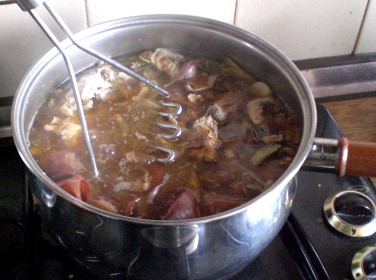 I brought the stockpot to the boil, then turned down the heat and simmered for an hour and a half.
I brought the stockpot to the boil, then turned down the heat and simmered for an hour and a half.
Every now and again, I crushed the contents down with a potato masher to break everything up and release more flavour.
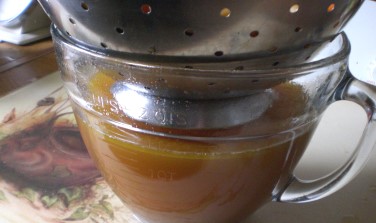 I drained the stock into a big jug, using the potato masher again to press out as much as possible
I drained the stock into a big jug, using the potato masher again to press out as much as possible
If I'd been concerned about producing a clear stock, I wouldn't have pressed it like this, and probably would have strained it through cheesecloth or muslin, but I'm planning to use it for soup or risotto, so a crystal-clear finish is not required.
 I made about two pints of rich stock - I poured this into two plastic containers and left them to cool.
I made about two pints of rich stock - I poured this into two plastic containers and left them to cool.
This will stay fresh in the fridge for up to a week, or may be frozen for use another time.
Chicken stock is a really versatile ingredient - if you've only ever used stock made from cubes or powder before, I would urge you to try (if nothing else) just this - make some stock from your next chicken carcass - you won't believe how good it is as a base for soup, risotto or paella.
Meal Three - Soup
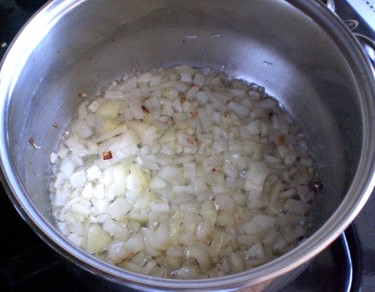 Meal three consists of a hearty soup based on this stock and the leftover vegetables and last bits of chicken.
Meal three consists of a hearty soup based on this stock and the leftover vegetables and last bits of chicken.
To start the soup, I gave it a flavour boost by frying some more onions in some of the reserved fat spooned out of the roasting pan.
As soon as the onions started to take on colour, I added some stock, along with the leftover potatoes, butternut squash and swede, then blended this until smooth.
 I cut the leftover carrot and chicken into small pieces and added this, along with the leftover peas and sweetcorn to the smooth soup.
I cut the leftover carrot and chicken into small pieces and added this, along with the leftover peas and sweetcorn to the smooth soup.
The result - served with buttered multi-seeded bread and (as an extra little treat, not really part of the plan) a small wedge of creamy gorgonzola cheese - is a satisfying and delicious meal - ideal for a midweek dinner after work, as it only took about twenty minutes to put together.
There was easily enough soup in the pot for generous servings to a family of four.
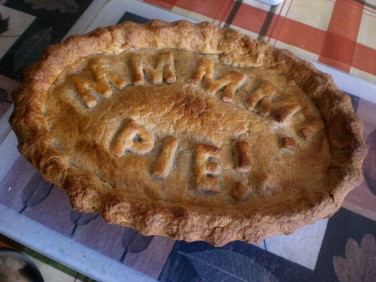 And here it is. The pie. A week or so later, we had chicken and sweet potato pie.
And here it is. The pie. A week or so later, we had chicken and sweet potato pie.
Mmmm! Pie! - I just made some rough-puff pastry and topped the premade (thawed) pie filling and baked it for half an hour to cook the crust. Delicious.
 And it goes on - there's always some leftover pastry - and with two hungry teenagers in the house, I can't let it go to waste, so I made a batch of jam tarts - really easy - just roll out, cut circles, bake them blind (empty) for four minutes, then add a teaspoon of jam and bake again for another four minutes, and they're done.
And it goes on - there's always some leftover pastry - and with two hungry teenagers in the house, I can't let it go to waste, so I made a batch of jam tarts - really easy - just roll out, cut circles, bake them blind (empty) for four minutes, then add a teaspoon of jam and bake again for another four minutes, and they're done.
Frugal Feasting
Here's a quick recap of the cost-saving tricks employed in this article:
- The chicken itself was a bargain buy
- Saving fuel by cooking several meals worth of food in bulk
- Extracting extra flavour out of the vegetable trimmings
- Saving fuel by re-using the parboiling water
- Re-using the parboiling water to flavour the gravy
- Saving fuel by using a triple steamer over one burner
- Re-using the fats from the meat for another meal
- Collecting every usable bit of meat from the chicken and rationing it across three meals
- Extracting extra flavour from the bones and leftovers
- Saving on dishwashing by re-using pans and dishes where appropriate (they're not actually 'dirty', after all - what's on them is't dirt - it's food)
The only part in all of this that entails additional energy/cost is the prolonged simmering of the stockpot - however, once it's arrived at the boil, the hob can be turned right down to the minimum extent for the simmer.
Flavour Is Money
So, what's all this obsession with extracting additional flavour from stuff? Well - put simply, flavour costs - it either costs money (sauces, seasonings, bought-in stocks), or it costs a little effort and a little forethought (but you get to keep the money in your wallet).
Other Tips
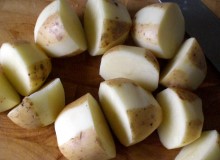 Half-peeled potatoes - if you try to roast potatoes with their whole skins on, they often end up more like tough jacket spuds, but if you peel them entirely, it's a waste (much of the flavour is in the skin)
Half-peeled potatoes - if you try to roast potatoes with their whole skins on, they often end up more like tough jacket spuds, but if you peel them entirely, it's a waste (much of the flavour is in the skin)
My compromise is to half-peel them - leaving strips of skin for flavour and texture, and peeled strips to allow the steam to escape, so that they crisp up nicely in the oven.
(On reflection, I realise I might also have thrown the potato peelings into the roasting pan and let them brown up into crispy shreds for use as a garnish).
 Sitting the chicken on a bed of onions - this prevents the chicken just burning onto the bottom of the pan - and the onions ideally caramelise to provide plenty of flavour for making the gravy.
Sitting the chicken on a bed of onions - this prevents the chicken just burning onto the bottom of the pan - and the onions ideally caramelise to provide plenty of flavour for making the gravy.
Total Cost
At the time of writing, the total cost for all of the ingredients for these three meals came in at well under £10. That's really something of a budgetary triumph.
There's Nothing New Here
I should of course make it clear that I'm not claiming I invented any of these ideas - there's almost nothing on this page that is a new idea, or that isn't already widely practiced by cooks the world over - what makes it interesting is how it all fits together into a plan.
Even More Economy
If you have freezer space, you can just throw all the bones from the chicken into a bag or other container and store them to make stock later - and keep adding more bones (for example those from a box of takeaway fried chicken, or a few bones from a rack of BBQ pork ribs and so on).
Keep on stacking up the bones until you have enough (or enough time) to make the stock)
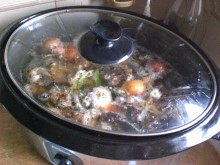 If you have a slow cooker (crockpot), you can use it to make the stock - I managed to fit the bones from three whole chickens into mine, plus six pints of water, onions, garlic, bay leaves and rosemary.
If you have a slow cooker (crockpot), you can use it to make the stock - I managed to fit the bones from three whole chickens into mine, plus six pints of water, onions, garlic, bay leaves and rosemary.
It takes all day this way, but it can just be left unattended to simmer while you do something else.
Variations
There's considerable scope for variation here - especially on meals two and three - how about a chicken and vegetable risotto for meal two, then for meal three, Bubble and Squeak (roughly smash up potatoes and leftover veg, form into patties and fry in the reserved chicken fat)
Waste Disposal
I don't have the space or equipment to be able to compost cooked food leftovers - and if it's done improperly, it can attract rats, so the inedible remains of the chicken and other stock items went into my 'brown bin' - this is collected weekly and goes to a municipal food waste handling centre to be composted/digested to make biogas and soil conditioner.
Over To You
I just know there will be people reading this who can extend this idea yet further - either with creative ideas for leftovers, or maybe even a way to get four (or more!) meals out of one chicken. Can't wait to hear from you...
